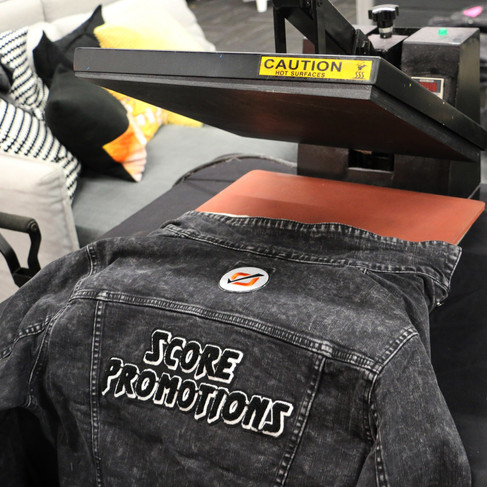In-House Decoration Techniques
- marketing84643
- Oct 25, 2024
- 2 min read

Score Promotions stands out from the competition by offering exclusive services, including in-house decoration capabilities. We personalize products with shorter lead times, even decorating prefabricated items upon request. With access to exclusive in-stock products in our warehouse, we provide clients with more options than the competitors. Here is what we offer:
The Breakdown
Decoration Technique #1 - Embroidery

A decorative technique used to stitch designs or logos onto fabric or other thicker materials. We use machine embroidery to create intricate, durable designs. The process involves pre-programmed machines stitching the design, often with multiple colors of thread, directly onto the material. Embroidery is known for its high-quality, textured finish giving a professional and long-lasting appearance. Examples: blankets, hats, bags, uniforms
Decoration Technique #2 - Pad Printing

A printing process used to transfer 2D images onto 3D objects. It involves using a silicone pad to pick up ink from an etched plate and then pressing it onto the surface of the item. The flexibility of the silicone pad allows it to conform to irregular shapes, making it ideal for printing on objects with curved or uneven surfaces. Examples: pens, golf balls
Decoration Technique #3 - Heat Transfer

An application method used to apply designs, logos, or images onto fabrics or other materials using heat and pressure. In this process, a design is first printed onto a special transfer paper or cut from vinyl. It is then placed onto the product, and heat (from a heat press machine) is applied to transfer the ink or adhesive to the material. It allows for vibrant, detailed prints and is often used for small production runs or personalized items. There are different types of heat transfer methods, including screen-printed transfers, patches, vinyl transfers, and dye-sublimation transfers. Examples: t-shirts, sweaters, bags, jackets
Decoration Technique #4 - C02 & YAG Laser Engraving
CO2 and YAG laser engraving are two types of laser engraving processes used to etch designs, logos or text onto various materials. Both techniques use focused laser beams to remove surface material, creating precise and permanent engravings. They differ in the types of materials they are best suited for and the technology behind them.
CO2 Laser Engraving
CO2 lasers use a gas mixture, primarily carbon dioxide, to produce the laser beam. This type of laser is ideal for non-metallic materials, such as wood, acrylic, glass, leather, plastic, paper, and rubber. CO2 lasers are commonly used to engrave intricate designs on softer materials. Examples: cutting boards, belts, name tags
YAG Laser Engraving
YAG (Yttrium Aluminum Garnet) lasers use a solid crystal as a medium and are designed for engraving on metals and other harder materials. YAG lasers are especially suited for metals like steel, aluminum, titanium, and even some plastics. They can achieve deep engravings and fine details, often used for designs that require high precision. Examples: pens, nameplates, awards
Part 2: Check back next month for more decorating techniques!



































Comments